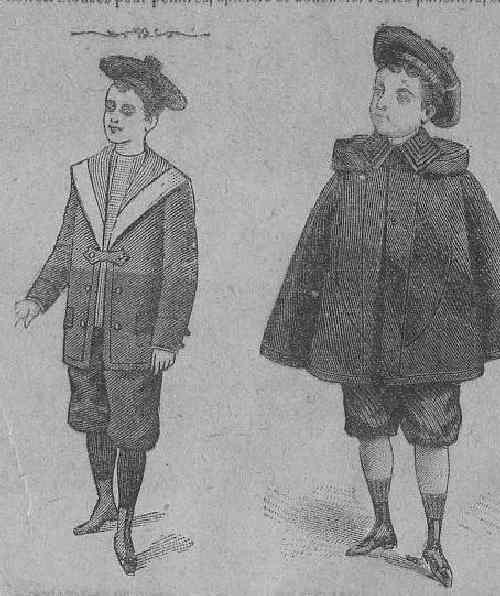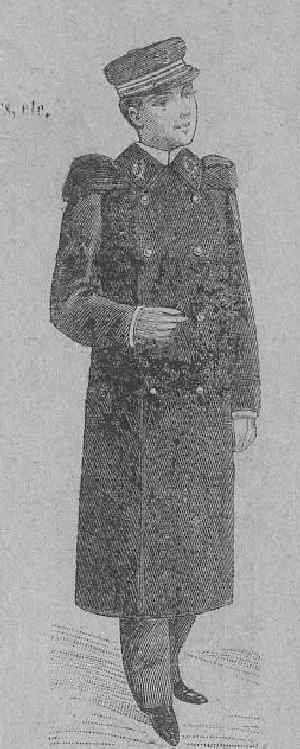
Nouvelles Galeries: Sailor Suits , 1900

Figure 1.--Boys commonly wore sailor hats and suits. The Nouvelles Galeries department store offered a wide range of sailor suits for boys, often in sizes up to about 12 years. Blouced knicker suits called "culottes" were the most common. Shown here is the costume marin and costume pour enfants.
|
Boys commonly wore sailor hats and suits. The Nouvelles Galeries department store offered a wide range of sailor suits for boys, often in sizes up to about 12 years.
Blouced knicker suits called "culottes" were the most common. Sailor caps were also very popular. A cape was offered for schoolwear with sailor suits. They were offered in blue, greym and beige. A sailor suit syle was also available for older boys attending colleges (secondary schools). These look like military school uniforms. There was, however, very limited ad copy text describing the garments. HBC does not have the month that this ad was published, but the lack of a white suit in dark material and the cloak suggests that it was a winter advertisement.
The Nouvelles Galeries advertisement is entitled, "Comptoir de vêtements pour enfants". It is captioned, "Cottes, vestes toile pour mécaniciens, vestes noires. Blouses pour peintres, épiciers et bouchers, vestes pátissiers, charcutiers, etc. This appears to be a rather cirious caption. It translates "Counter of children's wears ". It is further captioned, "Coats, jackets fabric for mechanics, jackets black. Blouses for painters, grocers and butchers, jackets for [pátissiers? =confectionary maker], porkbutchers, etc
Nouvelles Galeries
HBC at this time knows little about Nouvelles Galeries. In 1900 it was a large Paris department store. We do not know when it was founded or if it still exists.
Sailor Outfits
Nouvelles Galeries in 1900 offered several different sailor suit outfits.
Costume Marin
This is the left suit in figure 1. The ad copy reads, "Costume marin, double col, drap bleu et beige, culotte doublée. ... Fr 5.95. Le mém, cheviotte bleu, beige, ou grise entiérement doublé. Prix ... Fr 9.95." This translates as "Sailor suit, double collar, blue and beige cloth, doubled shorts (blouced knickers) ... Fr 5.95. The same in cheviot blue, beige, or gray entirely doubled. Price... Fr 9.95." HBVC was not sure what doubled shorts mean, perhaps two pairs of shorts. A French reader reports that "doublé" means "line up" (external cloth and other internal cheaper one). HBC believes that this refers to lining. Note that the illustration pictutes the boy wearing three-quarter length socks and strap shoes. The sizes for this suit are not specified.
Costume pour Enfants
This is the right suit in figure 1. The ad copy reads: "Costume pour enfants, de 3 à 12 ans, blouse bouffante, col marin ou chevaliére. Prix Fr 4.95. Le mém, avec garniture au col culotte doublé. Prix ... Fr 5.95." This translates as, "Costume for children (boys), from 3 to 12 years, puffing out blouse, sailor's collar or caveliers. Price Fr 4.95. The same, with trimming with the collar. Shorts (puffed knickers) doubled. The cavilier collar is not illustrated. Price... Fr 5.95." Note that this is the only one of the sailor suits that has a design on the dicky. The other dickies are plain. Translation note: There are many similarities between English and French. Englosh speakers can often guess at the meaning of words and vusa versa. Some of these silmilar cognates (similar lokking words), however, are not always used the same. In French, "enfant" is used as "child", not as "infant".

Figure 2.--These two illustrations show the quartiers-maître and pelerine capuchon.
|
Quartiers-maître
This is the left suit in figure 2. The ad copy reads: "Quartiers-maitre tissu bleu ou beige. Prix ... Fr 7.95. Quartier-maître cheviotte bleue, beige ou grise, double col. ... Fr 13.95 et 10.05. This translates as "uartier-maître blue or beige fabric. Price... Fr 7.95. Quartiers-maître cheviot blue, beige or gray, double collar. Fr 13.95 and 10.05." "Quartiers-maître is a naval rank, pesumaby the same as a petty officer in the U.S. navy. Cheviot was a hard-wearing woolen material commonly used in boys clothing.
Pelerine Capuchon
This is the right outfit in figure 2. The ad copy reads: "Pelerine capuchon mobile, molleton des Vosges. Depuis ... Fr 2.95." This would translate as "Raincoat with removable hood, made of "molleton des Vosges". ... Fr 2.95." Molleton is type of soft and thick cloth usually [first over?] mattress. Vosges is a french department (admistrative distriuct), presumably noted for the manufacture of this fabric. "Pélerine" is a type of inexpensive raincoat that in past years was only for children, or a somewhat different model for bike riders, called "pélerine cycliste" that would cover in front up to the
handlebars. "Capuchon" means hood (generally all pélerines do have hoods). So the garment here, "pélerine capuchon" translates to "hooded raincoat" and the full term "pélerine capuchon mobile" best translates to "raincoat with removable hood".
Culottes
The culottes are no pictured separately, but presumably are the same as pictured with the sailor suits. The ad copy reads: "Culottes pour enfants de 3 a 12 ans, cheviotte beige. grise ou bleue. ... Fr 3.95 et 2.95." This translates as "Shorts (blouced knickers) for children (boys) from 3 to 12 years, cheviot beige, gray, or blue. ... Fr 3.95 and 2.95."

Figure 3.--This is a coat with sailor suit styling for an older college (secondary school ) boy. This looks like a military school uniform. HBC is unsure, however, how common such military schools were in France.
|
Capote de Collégien
This is the older boy's uniform in figure 3. The ad copy reads, "Capote de collégien, cheviptte bleue, coubiée beatríx. Prix ... Fr 9.95. Le même, cheviotte extra, doublee Chine ... Fr 10.95." This translates as "Hooded blue colegian (secondary school) coat, cheviot, [coubiée beatríx?]. Price... Fr 9.95. The same one, extra cheviot, double [China? ... Fr 10.95. " I'm not sure what "coubiée beatríx" means. A HBC reader reports that "doublée Beatrix" means lined with Beatrix cloth, although I'm not sure what Beatrix cloth means. I'm also not sure about "China", perhaps a reference to a China cloth lining. China cloth may mean silk.
Caps
There is no text about the various styles of sailor caps shown in the illustrations, they were presumably offered fir sale on a different page. They do illustrate, however, the cap styles worn with sailor suits in 1900. Not shown are the broad-brimmed sailor hats with streamers worn by young boys.
Velvet Garments
A variety of velvet garments are mentioned at the bottom of the page, but not illustrated. It is not clear to HBC that these are boys' garments.
Clothing Costs
The cost of clothing fell substantially in the 19th century, especially iy after the invention of the sewing machine and various industrial processes in the late 19th century. Even so, clothes in 1900 were still much more expensive (in real terms) then is the case today. Compare the prices here with actual incomes. Annual salaries for different income levels: Factory manager: 67,000 Francs, Engineer: 8,000 Francs, Teacher: 2,500 Francs, and Workers: 680 to 2,500 Francs. Obviously for workers making only 680-2,500 Francs, the clothing costs here were a major expenditure.
Observations
A HBC reader writes, "Great information. It appears to me that at least three of the boys are wearing below the knee bloomer style knickers. Three out of the 4 are wearing what appears to be three quarter socks and one appears to be wearing stockings. Also, at least three of the boys are wearing shields (dickies) with their middy blouses." HBC believes that this is an important point. Sailor suits worn in America, Britain, and Germany during were much more likely to have kneepanys. We believe that these French styles of bloomer-like knicker pants were widely worn in several other counries such as Spain and Portugal. We do not know, however, at this time just what counties adopted this French style.
Christopher Wagner

Navigate the Boys' Historical Clothing catalog/magazine pages:
[Return to the Main French mail order 1900 page]
[Main photo/publishing page]
[Store catalogs]
[Fashion magazines]
[Main French sailor suit page]
[Main French smock page]
Navigate the Boys' Historical Clothing Web Site:
[Return to the Main French page]
[Introduction]
[Activities]
[Bibliographies]
[Biographies]
[Chronology]
[Clothing styles]
[Countries]
[Contributions]
[FAQs]
[French glossary]
[Boys' Clothing Home]
Navigate the Boys' Historical Clothing Web Site:
[Sailor suits]
[Sailor hats]
[Buster Brown suits]
[Eton suits]
[Rompers]
[Tunics]
[Smocks]
[Pinafores]
Created: November 13, 2001
Last updated: November 17, 2001





